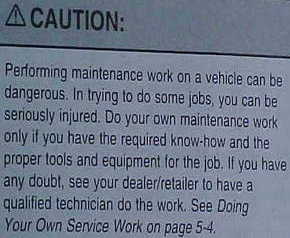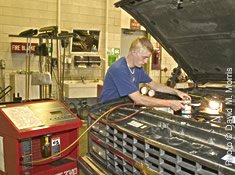Automotive Air Conditioning Safety

When dealing with automotive air conditioning systems safety is critical. In fact, this is one of the most dangerous systems on the automobile.
I have seen many of my coworkers and friends injured while working on AC problems. It’s my goal to help you prevent your own personal injury when diagnosing and repairing these components.
When in doubt let a professional auto mechanic perform the repairs. Automotive refrigerant or Freon known as R12, R134A and the newest type r-1234yf are all colorless and invisible when they’re in the vapor form. Do not breath the refrigerant vapors. Exposing yourself to the Freon gas may irritate your eyes, nose and throat.
Never rub your eyes or skin if you’ve touched the refrigerant or its lubricant.
AC components are lubricated using Polyalkylene Glycol (PAG) oil mixed with Freon. This method is similar to a 2 stroke engine that uses oil mixed with gasoline.
Back when I started turning wrenches we where so ignorant of the dangers from this system that we actually leaked checked it using a small torch. The flame would flair up when it came across the freon leak. Never do this, because when you burn refrigerant the by product is Phosgene gas. This is real bad stuff to inhale.
Automobile Air Conditioning Danger

One of the scariest injuries I have seen is when a car mechanic will get liquid Freon in their eyes. The liquid refrigerant will actually freeze the eyeball and cause frostbite damage to the eye surface.
For god sake wear safety glasses around refrigerant. The damage to your eyes in most cases would be permanent and could leave you blind. Liquid refrigerator can also cause frostbite damage to the skin surface.
It is recommended that you wear long-sleeved shirts and pants, and also protective gloves. If you should come in contact with liquid Freon, the best advice is to run the affected area under cool water for 15 minutes and then seek immediate medical attention.
The systems high pressure can cause severe injury to your eyes and/or skin if a hose or line were to burst. Always wear your safety gear when working around the AC system, its components and its refrigerant. It is also advisable to wear gloves when connecting gauges or installing Refrigerant in the automobile.
Automotive AC Safety
I’ll mention it again, because it’s so important, in the old days they would use a propane torch to identify leaks in the air-conditioning system instead of a leak detector like the one on the right. Never use the torch method for detecting leaks.
If the vapor is inhaled from a flair up it can cause severe respiratory damage that’s not reversible. I’ve also seen some guys heat the refrigerant container with open flames.
This is not the way to do it. If you need to heat your refrigerant container to raise its inside pressure the container should be placed in warm water bath.
Always be careful when handling refrigerant containers. This applies to the convenient one-pound sized cans or the 30-pound refrigerant containers that are found in many automotive shops.
Remember that R12 Freon and R134-A should not be mixed in automobile air-conditioning systems. All original factory installed car ac systems can be clearly identified by under hood labels that indicate the type of Freon that is used.
Most manufacturers identify the type of refrigerant used by labeling the compressor as well. Also look for a label with the words caution, system to be serviced by qualified personnel.
This label or plate can be found under the hood near a major component of the system the location differs by year make and model but will tell you what kind of refrigerant is used, as well as the type of refrigerant oil and the amount the system holds.
This label is worth finding and can be critical in diagnosis. Often systems that do not cool properly are overcharged or contain contaminated Freon. Regardless you should always take the time to identify what type of Freon is in the system before beginning any diagnosis and repair of that system.
The air condition section of this website is very popular. Learn more about the theory and operation of automotive air conditioning. You can find more automotive air conditioning safety gear and information about safe practices on my section that deals with nothing but auto repair safety.
The homepage is up next and is a great place to get more information about this car repair website. This next link takes you there from this article about automotive air conditioning safety.

